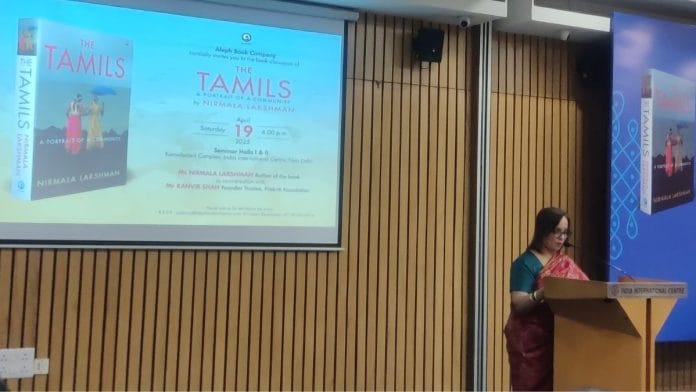New Delhi: A stone inscription in a Jain temple in Madurai, made centuries ago, records a land grant from a Shaivite priest and ends with a warning. Do not harm other faiths. In an age when temples were often spaces of exclusion, this stone stood as evidence of a different civilisational instinct—one of coexistence, not conquest.
“It’s a strong message that shows how the Tamil region allowed multiple faiths to exist side by side,” said Nirmala Lakshman, Chairperson of The Hindu Group of Publications and author of The Tamils: A Portrait of a Community.
At the launch of the book at Delhi’s India International Centre on 19 April, Nirmala Lakshman and Ranvir Shah, founder and trustee of Prakriti Foundation, engaged in a conversation exploring the book’s vivid portrayal of the Tamil community’s rich cultural, social, and historical identity.
Through stories of religious syncretism, such as the spiritual journey of a British collector, Lakshman painted a picture of a society where faiths coexist in harmony. Yet, beneath this lies a more complex reality—one where caste exclusion still shapes Tamil life. The author’s exploration is both a historical recount and a personal journey of rediscovery. It uncovers the deep pride and resilience that define Tamil identity, balancing tradition with modernity.
Embracing pluralism, unmasking caste
In the book, Lakshman looks at the remarkable religious syncretism of Tamil Nadu—a land where faiths haven’t just coexisted, but intertwined in deeply symbolic ways.
Consider the story of Rous Peter, a British collector in Madurai. Each morning, he would pause at the Meenakshi Temple, remove his slippers, and bow before the goddess. Though a foreigner, his reverence earned him a Tamil name – Peter Pandian. One night, he dreamt of anklets and was awakened by a little girl urging him to flee his home. As he stepped out, a torrential flood washed his house away. Believing the goddess had saved his life, he later donated golden slippers to the temple. They remain in its basement to this day—quiet testimony to a spiritual bond that crossed continents.
Another tale is of Thulukka Nachiyar, or Tughlaq Princess, a northern Muslim princess who, smitten by Srirangam’s Lord Ranganatha, journeyed south to marry the deity—only to die before reaching the shrine. In honour of her devotion, a shrine was consecrated to her within the temple grounds. To this day, she is worshipped as a goddess—a Muslim one—in the Tamil tradition.
“There is a great deal of friendliness that pervades between all these communities. It’s more about caste, I think, than religion,” said Lakshman. “You know, people of different faiths, but belonging to the same caste, could intermarry. It’s the kind of social flexibility that exists in Tamil Nadu.”
But while religions mingle and merge, caste remains the sharper line of exclusion.
Lakshman recalled meeting a priest at Srirangam Temple who was very upset because “now even Scheduled Castes are being given jobs.”
His discomfort wasn’t with religion—it was caste entering what he believed was a sacred space.
Even reformist spiritual movements, she said, rarely challenged this hierarchy. “They were in the forefront of the revivalist movement and the spiritual movement. And all of that also meant that they were creating a very structured and hierarchical system, which didn’t allow for inclusivity.”
The consequences were far-reaching. “There were many more backward castes and Dalits who didn’t even know that this was going on. They were totally excluded from the public sphere,” she said. Entire communities found themselves outside political and cultural conversations that shaped modern Tamil society.
Temples—symbols of Tamil religiosity—also mirrored this divide. There were temples in villages that would not allow Dalits or people of certain castes to enter. But rejection bred resilience. These communities would often have their own shrines, where they created their own deities.
These acts weren’t just alternatives—they were assertions of dignity, belief, and belonging. “And there are still many temples that have only upper-caste access still,” she said. “That kind of exclusivity still exists.”
Also read: Art and India’s food history—Lakshman barbecues, Krishna drools over butter
Exploring Tamil identity
Every morning, a young Lakshman would watch her grandmother chant verses from Silappathikaram, a Tamil epic. This ritual passed through generations, became a guiding memory for Lakshman as she explored Tamil history and culture, never losing sight of the intimate stories that shape people’s identity.
“I would wake up and hear my grandmother chanting Silappatikaram each morning like a prayer. It’s that ingrained sense of literature, music, and poetry that gives people an identity that cannot be shaken,” she said.
Growing up in a family deeply rooted in Tamil culture, Lakshman recalled how her family, though not particularly ritualistic, maintained a connection to Tamil heritage. This was through their involvement in local temples and their exposure to the Tamil language and arts.
“I think the thing that struck me most as I worked on this book was how much I didn’t know about my own people, my own culture,” said Lakshman. “I grew up in an English-medium school, studied Hindi and English, and didn’t really pay much attention to Tamil. But as an adult, when I started researching the book, I began to realise how rich Tamil culture is.”
This thread of rediscovery runs through the book, as Lakshman reflected on her own awakening to the depth of Tamil history, language, and culture. She admitted that while she could read Tamil newspapers, her grasp of the language was limited. She often wished she had learned more and paid closer attention to its beauty.
(Edited by Aamaan Alam Khan)






